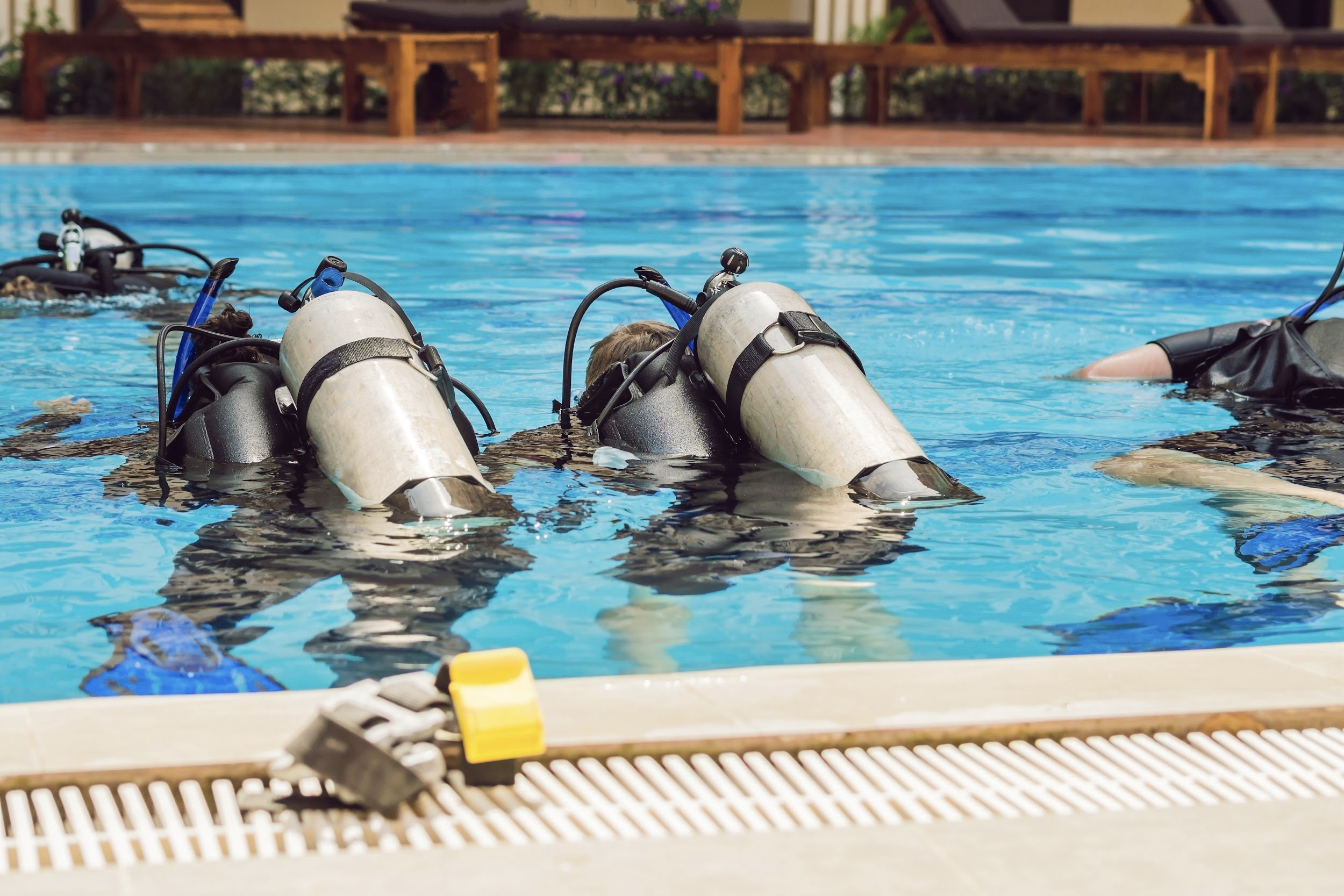How to Get a Diving Certification: Your Guide to Scuba Diving Training

- A scuba diving certificate is important for recognising a diver’s qualifications and skillset, proving they have obtained specific scuba dive training from an accredited organisation or instructor. You must present a valid dive certification card in many scuba diving locations.
- There are a few prerequisites required to start scuba diving training. You will be expected to be in fairly good health, with no respiratory issues and normal vision. You will also need to be able to swim and be comfortable swimming while wearing a mask and fins.
- Scuba dive training consists of classroom sessions and in-water practice with an instructor, during which divers learn the principles of buoyancy control, communication, problem-solving and safety guidelines for various dive conditions.
- Upon completing the required classroom and in-water scuba diving training, participants must pass a comprehensive examination comprising written and practical components covering all aspects of being a certified diver.
If you’re looking for an exciting way to explore the planet, scuba diving is one of the best activities you can do. Scuba diving can take you to some of the most exotic locations on Earth. Not only will you see some of the most amazing marine life you can imagine, but you’ll also be able to experience the freedom of being underwater.
However, before starting your underwater adventures, you must get certified in scuba diving first. Getting dive certification requires taking classes and passing tests, but it will open up a new realm of possibilities for exploring the depths of the oceans and seas worldwide.
In this article, we’ll look at the prerequisites needed to start scuba diving. Then, we’ll take you through the steps needed to get yourself certified. Finally, we’ll examine your certification and the steps you can take after passing your exams. Let’s dive in!
Do You Need Scuba Certification to Scuba Dive?
No, you don’t have to be certified to scuba dive. If you own the correct equipment, there are many places where you can dive. However, this isn’t something you should consider.
Scuba diving is not something you can self-teach. Beyond actual technique, many don’t realise a sizeable amount of classroom learning is involved, and prospective divers must be taught things such as buoyancy control and ascent procedures. If you become a certified scuba diver, you will have the knowledge to dive more deeply, further away from shore and for longer periods.
However, the most important aspect is safety. If you’re certified, you are fully trained in the safety procedures and are aware of the risks. This is vital not only for your safety but others around you. If you’re uncertified, you risk injury or even death, and you could be held liable if your actions result in injury or death to others.
Therefore, getting certified through a legitimate scuba instructor or scuba dive training organisation is important if you want to dive safely and responsibly.
Prerequisites Before You Begin Scuba Dive Training

There are several steps toward getting certified as a scuba diver. The process is fairly straightforward, and you shouldn’t encounter too many problems either getting started or going through the process. There are, however, a few prerequisites that you’ll want to be aware of.
Cost: Each scuba diving course can cost between around $300 and $500, depending on where you take your instruction. This is sometimes a single payment for the whole course, while others will break the cost down into classroom theory costs and in-pool session costs. These fees will be repeated for each subsequent level of course you take.
Physical requirements: You do not need to be an Olympic athlete, but you do need to be in reasonably good health. However, you should have no serious medical conditions, particularly those affecting respiration. You should be able to swim at least 200 metres comfortably and must have good vision (either uncorrected or corrected to normal). If in doubt, you should approach an instructor or school and make inquiries.
Time requirements: Most scuba diving certification courses include scuba diving lessons in a classroom and practical in-water sessions. The total time will depend on the agency or organisation providing your instruction. However, typically this time ranges from between four to five days of combined scuba diving lessons and water sessions to complete dive certification.
How to Get a Scuba Diving Certificate
If you fulfil the above criteria, it’s time to go ahead and start your scuba journey! We’ve broken this guide down into six easy steps that will help you get through the entire process:
Choose a Scuba Certification Agency
Before you start your dive certification process, it’s important to research the various scuba certification agencies available. Organisations have different requirements and procedures, so choose one that’s right for you. There are several scuba diving certification agencies, and these include:
Professional Association of Diving Instructors (PADI): Founded in 1966, PADI has issued over 29 million diving certifications since its inception and is the largest and most popular scuba certification agency globally. Courses range from entry-level to advanced, with several specialised programs also available.
National Association of Underwater Instructors (NAUI): An internationally-recognised certification agency since 1959, the NAUI is headquartered in Tampa, Florida, with scuba diving training centres and instructors worldwide. They also have several resorts and stores.
Scuba Schools International (SSI): SSI offers a range of courses and specialities tailored to those looking for more advanced scuba dive training. They also have several online courses for those who don’t have access to local dive instructors. The group is headquartered in Colorado and has over 2,500 dealers and regional training centres across the globe.
British Sub-Aqua Club (BSAC): Based in the United Kingdom, this is one of the world’s oldest and most respected scuba organisations. The BSAC has been operating since 1953 and provides a range of beginner to advanced-level courses for those looking to learn how to dive safely. They operate through 1600 local dive clubs and over 400 diving schools worldwide.
Confédération Mondiale des Activités Subaquatiques (CMAS): The CMAS is a European-based organization that offers courses and certifications for recreational, scientific and technical diving. They have over 130 national federations on five continents and are the primary governing body of competitive scuba diving in Europe, being based in Italy.
International Association of Nitrox and Technical Divers (IANTD): This agency offers many courses and certifications for technical, recreational and closed-circuit diving. Depending on your experience level and goals, you may want to consider this agency as it provides more advanced and in-depth scuba diving training than others. They have instructors in over 60 countries and are based in Florida.
Technical Diving International (TDI): Founded in 1993, TDI is a certification agency that provides technical, closed-circuit rebreather and recreational courses. They have an extensive range of instructors worldwide and provide industry-leading scuba dive training.
Scuba Diving International (SDI): SDI is a relatively new dive certification agency that offers courses in recreational diving. They have a wide range of specialities and are recognised around the world. They also offer a full range of entry-level to advanced certifications. They are the sister company of TDI and teach recreational diving through the lens of professional technical diving. They are the only certification agency that requires dive computers from the start of training.
As you can see, various scuba certification agencies are available. Researching the one best suited for your needs and what you want to achieve is important.
Choose a Certification Course That’s Right for You
Once you’ve chosen the right agency, it’s time to select your certification course. Typically, entry-level courses will include basic concepts and skills required to scuba dive safely. More advanced courses may include specialities such as deep diving, underwater photography or reef diving. You may also choose to become an instructor or divemaster.
If you’re reading this article, it’s likely you’re looking for your first certification and, as such, will want entry-level courses. However, your course level will depend on your existing certification. Most instructors and scuba diving training centres will not allow you onto advanced courses without proof that you’ve achieved an introductory level.
The next step is finding a qualified instructor or scuba dive training centre. The best way to do this is by searching online for one close to your home. It’s also important to ensure the instructor is certified with your chosen organisation and that the training centre is approved.
Purchase Your Scuba Diving Equipment

Before starting your course, you must purchase all the necessary diving equipment. Things like fins, masks and snorkels are essential for a safe dive, and you must have these things before you can start scuba diving training.
Whether you need more advanced equipment depends on your scuba dive training centre. Some locations will include renting things such as a buoyancy control device (BCD), dive computer and cylinder as part of the cost for your in-water training sessions. Others, however, will not. Make sure you find this out before starting your course, as these are the most expensive items of scuba diving equipment. You may also be required to have a wetsuit or drysuit, depending on the diving environment.
Here at Agulhas, we know that money can be a worry when you’re just starting. That’s one of the reasons why we produce our beautiful diving gear that’s also kind to your bank account. All our diving equipment is modular, meaning that when one piece gets damaged, you don’t need to replace the whole thing! Read on for more about how Agulhas is revolutionising the world of diving!
Complete Your Scuba Diving Lessons on Theory
Most certification courses will combine classroom-based scuba diving lessons and practical in-water sessions. These theory lessons will be done in a physical classroom or online via e-learning. During these scuba diving lessons, you’ll be instructed on the basics, such as dive safety, scuba terminology, equipment maintenance and basic underwater skills.
It’s important at this stage to familiarise yourself with rules and regulations and pay particular attention to safety protocols. These will not only keep you safe but also those around you.
Participate in In-Water Scuba Diving Training Sessions

Once you’ve completed your scuba diving lessons on theory, you must hit the water for some practical training. During these sessions, you’ll learn essential skills such as buoyancy control, air management and basic navigation. In-water training will occur first in the pool and then in open water.
During the pool sessions, you will be taught how to use all your equipment and safety protocols; while in open water, you’ll practise these skills in a real-life underwater environment. Your instructor or divemaster will always be with you and will assess your progress throughout the sessions. How many sessions you have will depend on your diving school.
Take Your Certification Exam and Certification Dive
Before being certified, you must pass a written exam that tests your knowledge of diving theory, safety and emergency procedures. If you fail the exam, you must retake it before proceeding.
Alongside your theory test is your certification dive. This is usually carried out with an instructor and will assess your ability to safely and competently perform all the skills you’ve been taught. On successful completion of this dive, you will be awarded the certification. You may be required to perform multiple dives depending on the certification agency.
Once you’ve passed all the tests and demonstrated your knowledge and safety, you will receive an internationally recognised scuba diving certificate card.
What Is a Scuba Diving Certification Card?
Diving certification, also known as a C-card, is a card given to divers who have completed an approved scuba diving certificate course. The card proves the diver has learned the necessary skills, knowledge and safety protocols for safe and enjoyable dives. Scuba shops, charter boats and resorts may all request to see a valid card to provide services.
A certification card is issued by a recognised training agency such as PADI, SSI or NAUI. It contains information such as the diver’s name, certification level, date of issue and expiration date. It’s important to note that the entry-level grade for various certification bodies is not always equivalent, as different courses teach different skills.
The Next Steps after Your First Dive Certification

Once you have your first diving certification, the world is your oyster. You can explore our planet’s most beautiful and unique underwater environments as a certified diver. From coral reefs to shipwrecks, there’s something for everyone and every level of experience.
Many courses are also available to allow divers to expand their skills and knowledge. These include advanced open water, rescue diver, divemaster and instructor certifications. Certifying in these higher-level courses will open up even more opportunities for you as a diver, such as leading dives, teaching others how to dive and accessing greater depths.
In addition to learning new skills, you can join communities of like-minded divers. These social networks are great for making friends and sharing stories with other divers who have the same interests as you. This is a great way to gain access to exclusive dive sites, learn tips and tricks on equipment and get advice from those more experienced than you.
You should also ensure that you maintain proper logbooks, as this is primary evidence of your range of experience. Remember to join a dive insurance plan in case something unfortunate were to happen on a dive and, of course, stay up to date on your training.
So, now that you understand the process of how to get your first diving certification and what it can offer you, there’s nothing left to do but get out there and explore all the wonderful underwater world on offer!
Introducing Agulhas
Whether buying your first diving kit to get started with training or upgrading your equipment as you become more experienced in the water, Agulhas is your first stop for all your diving equipment.
Agulhas is revolutionising how diving gear is made. Our unique modular construction allows you to replace any part of your diving equipment without paying extra money to get a new item. Not only does this cut down on costs, but it also reduces waste, adding to the sustainability of our products.
All our diving gear is made with the most sustainable materials possible, helping reduce ocean pollutants. Our mission is to give you the best performance possible while providing an environmentally friendly solution.
So if you’re looking for reliable, efficient and sustainable diving gear that won’t break the bank, look no further than Agulhas! Why not explore our catalogue to see what we offer or check out more in-depth guides to scuba diving and freediving throughout our website?
Conclusion
Getting your scuba diving certificate is an important step in becoming a certified diver, so it is important to ensure you complete your course to the highest possible standard. With a certification card, you can access dive sites worldwide and explore underwater caves, wrecks and other exciting underwater locales.
No matter what stage of your scuba diving journey you’re at, Agulhas is here for you. We provide you with the best sustainable and efficient diving gear to make your dive safe and enjoyable. So, why not take a look at what we have to offer? Happy diving!
FAQs
What is included in a scuba diving certification course?
A typical scuba diving certification course includes classroom instruction and lectures on underwater safety awareness, technical dive theory, dive physics and physiology, equipment use and maintenance, navigation skills, dive planning and problem management. In addition, students will participate in pool and open-water sessions to learn how to properly set up their gear, handle emergencies and perform basic dive manoeuvres.
Can I take part in a single-day course for my scuba diving lessons?
It depends – many organisations offer standard one-day ‘Try Dive’ programs, which allow non-certified individuals to experience breathing underwater safely without having obtained any previous certifications yet. These programs often act like introductions into scuba diving but don’t provide certifications upon completion; instead, they give individuals an idea of what it’s like before committing themselves fully to taking proper full-length courses leading towards real certifications later down the road.
Do I need special diving gear for my scuba diving?
Yes, all divers will need their scuba gear, including fins, mask, snorkel, regulator, BCD (buoyancy control device) and other accessories such as weight belts/weights and dive computers. Some dive centres may provide rental gear; however, most people eventually purchase a complete set-up. Here at Agulhas, we have you covered for all your diving needs, so check out our catalogue for scuba gear that is revolutionising the industry!






